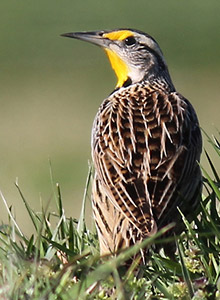The Eastern Meadowlark, Wake Audubon’s Bird of the Year for 2013, is along with its counterpart the Western Meadowlark a bird of the grasslands and and farms of rural America. Meadowlarks favor taller grasses for nesting and short, often grazed lands for food which consists mostly of insects, caterpillars, and some seeds.

Eastern Meadowlark
The two distinct but very similar species of this cheerful singer extend across much of North America with the Western’s range dipping as far south as southern Mexico while the Eastern’s range reaches to northern South America. The Western’s range goes as far north as the southern half of British Columbia and even higher in Canada’s prairie provinces, while the Eastern’s northern limit includes the Canadian Maritime provinces. The two species overlap considerably in the Mississippi Valley and the Great Lakes states while a possible third species, Lilian’s Meadowlark, occupies a niche in the southwestern United States as far west as mid-Arizona. Ornithologists have not made a final determination as to whether or not Lilian’s Meadowlark is a distinct species or a variation of the Eastern Meadowlark. The degree of range overlap of the two species makes sight distinction very difficult because of the subtle differences in their markings. Experts claim the surest way to distinguish them is by sound. The Western Meadowlark has a bell like quality to its vocalizations, whereas the Eastern Meadowlark’s voice is more flutelike, although each species has a repertoire of sounds. The voices of both species provide an enchanting quality to the open and often wind blown country they prefer. In terms of appearance both the Eastern and Western Meadowlark have somewhat squat bodies with short tails and long beaks and a profile that resembles somewhat that of the European Starling. Viewed from above or behind, the Meadowlark’s light brown or tan base of feathers is marked with black spots and stripes enabling the bird to blend into the vegetation it lives in. A frontal perspective, on the other hand, reveals a bright yellow breast with a pronounced V shaped black band giving the Meadowlark a most handsome even striking appearance. One subtle difference that helps with visual identification of the two species is the white feathers on the edges of their tails that are visible in flight. The Eastern Meadowlark has a wider border of white feathers on its tail than its western counterpart. Their attractive appearance and joyful voices have made these birds a favorite among the people who share their habitat. Perhaps it’s because both species of Meadowlark make good company in often lonely landscapes.
Wildlife expert John Connors recommends that Wake Audubon members and friends in the Raleigh area can best find Eastern Meadowlarks at Mid Pines or NC State’s agricultural lands on Lake Wheeler Road south of Tryon Road, and on the southeast and southwest corners of the intersection of Edwards Mill Road and Reedy Creek Road (think Prairie Ridge on the east side of Edwards Mill and the cow pasture at the west side). NCSU’s vet school cow pasture adjacent to the University Club on Hillsborough Street is another good location to find Meadowlarks.
Bird of the Year Index